Here in Vermont, we dream of June during the darkest days of January. Verdant wooded hillsides glowing brightly under a robin egg sky. Warm afternoon breezes rolling through the valleys as we lounge by the clear waters of a cold river. The chorus of birds waking us each morning. The smell of freshly cut grass wafting through the window. Butterflies skipping from one flower to the next. We forget about the clouds of black flies, the hum of the mosquitoes and the rainy days. June is a dream here. It’s days last forever. Here’s some natural history wonders for the month.
A Pitcher Plant’s Web of life
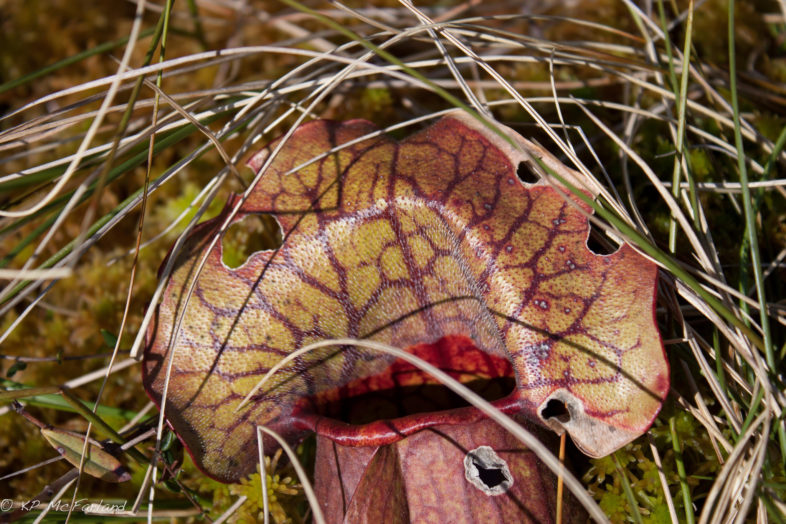
Pitcher Plant. /© K.P. McFarland – www.kpmcfarland.com
Find yourself a sphagnum covered bog in New England and you’re sure to find a pitcher plant. But peer a little closer and you’ll find a whole self-contained world within it.
Northern pitcher plants (Sarracenia purpurea) grow as a rosette and produce 6 to 12 new tubular leaves each season. A bunch of pitchers next to each other likely belong to the same individual. New leaves open every few weeks and the “pitcher” that is formed fills with rainwater. Leaves capture the sun for photosynthesis during their first year, but as they age they are used by the plant to capture prey for 1 to 2 years before they fall apart. The small prey die and break down in the pitcher. The plant absorbs nutrients from the prey that are not available from the acidic bog.
The prey are attracted to the pitcher by a sweet sugary secretion on the lip of pitchers, as well as color and scent. Because of a waxy, slippery coating on the lip of the pitcher, they sometimes fall into the water inside the pitcher and find it difficult to climb out because of very fine, downward-angled hairs on the walls of the leaf.
Nicholas Gotelli from the University of Vermont and Aaron Ellison from Harvard Forest studied the effects of increased inputs of atmospheric nitrogen from acid precipitation. They discovered that as more nitrogen is added to bogs the pitcher plants shift from producing water-filled pitcher-shaped leaves to flat leaves that are used for photosynthesis. This is an amazingly fast morphological change.
There is a complex web of life living within each pitcher. The base of the food web is comprised of captured prey, mostly ants and flies. These are shredded and partially consumed by Pitcher Plant Midge (Metriocnemus knabi) and Pitcher Plant Fly(Fletcherimyia fletcheri) larvae. Shredded prey are processed by a host of bacteria and protozoa. These are in turn prey to a filter-feeding rotifer (Habrotrocha rosi) and a mite (Sarraceniopus gibsonii). Larvae of the Pitcher Plant Mosquito (Wyeomyia smithii) feed on bacteria, protozoa, and rotifers. Older mosquito larvae (third instar) eat rotifers and smaller mosquito larvae (first and second instar).
Gotelli and Ellison found that the web of life extends outside of the pitcher too. The leaves exude a sugar that attracts ants. Some ants forage successfully while a few fall into the pitcher. Two moths, the Pitcher Plant Moth (Exyra fax) and The Pitcher Plant Borer (Papaipema appassionata), only use the Pitcher Plant as a host plant for their caterpillars to feed and grow. The larvae of the Pitcher Plant Moth can drain and kill individual pitchers. The Pitcher Plant Borer feeds on the roots and can sometimes kill the entire plant. Repeated or heavy feeding by the moth larvae reduces the amount of available sugar to the ants.
Check out the hidden world of the Pitcher Plant the next time you are on a boardwalk through a bog. Here are some bogs with boardwalks in Vermont:
Butterfly Endurance
With the temperature in the high 80s yesterday, I may have overdone it on my mountain bike. I climbed hill after hill giddy with the adrenaline of the previous downhill thrill. Today, my legs feel like they are filled with lead. Athletics have a way of showing your age, but I was heartened to learn that I wasn’t alone. It turns out that butterflies have the same age old problem.
In 2009 scientists in Sweden reported that the flight endurance of a small butterfly called the Green-veined White decreased with age. The Green-veined White (Pieris napi) is found across Europe and Asia, including the Indian subcontinent. Some scientists believe that the Mustard White, a woodland dependent species found here in the Northeast, is a subspecies of Pieris napi while most now align it as its own species, Pieris oleracea. Either way, they are very closely related and look quite alike.
How do you test endurance in a butterfly? The scientists released individual butterflies 6 feet in the air and when they landed, they were prodded to fly again and again, and yet again until they were too exhausted to fly. A simple stopwatch yielded the total flight time. They tested three age groups that were raised in captivity. One group was kept in cages for 10 days and another was kept in the cages for 5 days. The third group was 1-day-old butterflies newly emerged from the chrysalis and roaring to go. These butterflies probably only have an average adult life span of about two weeks.
It didn’t matter if they were male or female, young and middle-aged butterflies performed about the same. But by the time the butterflies were 10 days old they were over the athletic hill. I guess I must be about 8 in butterfly age. I just can’t keep up with the newly emerged anymore. I’ll just have to ride more wisely.
Flying Tigers
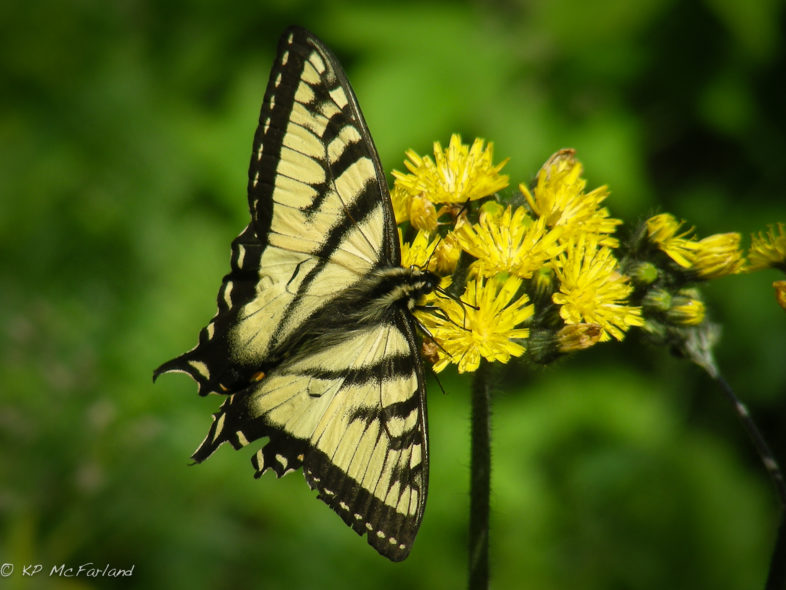
Canadian Tiger Swallowtail (Papilio canadensis) in Vermont. / © K.P. McFarland – www.kpmcfarland.com
And you thought you had trouble telling one butterfly species from another. Lepidopterists – scientists who study butterflies – have been tripped up by tiger swallowtails for centuries.
The tiger swallowtail butterfly, a rather large, yellow butterfly with black tiger stripes. Each spring and early summer they flutter over the hills and valleys of eastern North America, sometimes in great numbers. But figuring out exactly what is, and what is not, a tiger swallowtail has baffled lepidopterists for more than three centuries.
The tiger swallowtail was the first butterfly to be painted by an artist from the New World. John White painted one on Roanoke Island, North Carolina, in 1587 while serving as the expedition leader of Sir Walter Raleigh’s third trip to America. Despite exaggerating the wing shape, his details were relatively accurate.
Linnaeus, the father of modern taxonomic naming, called the species Papilio glaucus in 1758. For over 150 years thereafter, it was commonly known as the tiger swallowtail. But Linnaeus had actually named the tiger swallowtail from a black-colored female – a rarer version of the group that looks just like the more common yellow females, except that the background color is darkly pigmented. These dark females generally occur from Massachusetts to Florida, the southern portion of the butterfly’s range.
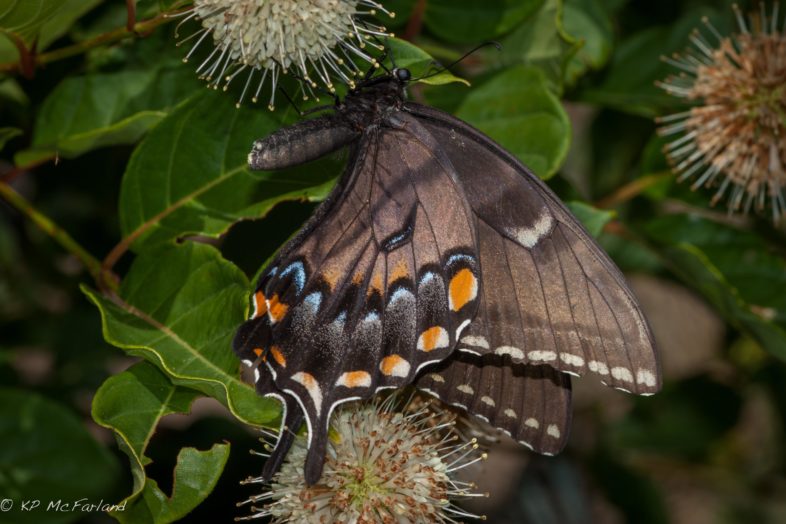
Eastern Tiger Swallowtail (Papilio glaucus) dark form female nectaring Buttonbush in Maryland. / © K.P. McFarland – www.kpmcfarland.com
Why are there dark-colored females? They are thought to have evolved to mimic the dark color of the foul-tasting and poisonous pipevine swallowtail butterfly. This is called Batesian mimicry, when one otherwise palatable species evolves to closely resemble an unpalatable cousin.
Linnaeus also observed the more common, yellow-colored female tiger swallowtail but decided it was another species altogether. A contemporary of Linnaeus documented a male tiger swallowtail, which is also yellow, but decided it, too, was its own species.
In the 1800s, biologists realized that the three species were only differentiated by color and lumped them together under the common name, “eastern tiger swallowtail.” Starting in at least 1906, however, lepidopterists noticed that the more northern populations were smaller and had slightly different markings. Some began recognizing this as a subspecies of the eastern tiger swallowtail and called it canadensis.
In 1991, biologists from Michigan State University announced that they had enough evidence to declare canadensis a separate species altogether – the Canadian Tiger Swallowtail. Their evidence included genetic differences, color and size differences, caterpillar food-plant use, lack of black-colored females in canadensis, and only a very narrow hybrid zone between the two species. It is now widely accepted that Eastern Tiger Swallowtails are found southward and Canadian Tiger Swallowtails are found northward.
The range of the Eastern Tiger Swallowtail just barely makes it into Vermont and New Hampshire. Most of the tiger swallowtails we see around here, therefore, are Canadian Tiger Swallowtails.
Generally, Canadian Tiger Swallowtails are flying around from the beginning of May until the end of June (later in higher elevations), while Eastern Tigers fly from June into October. So if you see a tiger swallowtail sailing over a meadow from mid- to late summer, it just might be an Eastern. But even up close, they look very similar. The Eastern is larger, with the underside marginal forewing band broken into yellow dots separated by black borders. On the underside of the Canadian hind wing, the black line nearest the body is very wide. Minute details for sure. Even worse is that, in the hybrid zone between species, there are many that appear intermediate. In Vermont and New Hampshire, we are in the thick of the intermediate zone.
But the story doesn’t end here. In 2002, another potential tiger was described by two lepidopterists, Harry Pavulaan and David Wright. “When it became apparent that there were inconsistencies in the natural history of mountain populations versus lowland populations of tiger swallowtails, an intensive effort was made to study the field biology of the mountain populations,” said Pavulaan. They have named it the Appalachian Tiger Swallowtail and affectionately refer to it as “Appy”. So far, it is known only from the central and southern Appalachian Mountains.
Why do tiger swallowtails come in so many varieties that biologists have been trying for centuries to pin them down? Probably because tiger swallowtails have what are known as sibling species – two or more populations that are reproductively isolated from one another yet so similar in outward appearance as to be lumped together even by experts. Careful, intense study of details such as anatomy, biochemistry, and behavior can bring sibling species to light. But there can be many dead ends and tricks that confuse biologists.
If you want to wade into world of tiger identification, now is the time. The lovely Canadian Tiger Swallowtails are flitting over meadows near you.
Meat Eating Trees
Plants are not often thought of as predators. They’re the nice guys. With over 300,000 species known to exist, only a small fraction are known to be meat-eaters. In our northern bogs, for example, insects are trapped on the sticky hairs of sundew or drowned in the pitcher plant’s water.
Research now suggests that at least one tree may owe its size to more than just sun, water and good soils.
The Eastern White Pine is one of the tallest native tree species in our region. Give them a few hundred years in ideal floodplain habitat, with roots sunk deep into sandy and silty soils and protected from winds and lightning by hillsides, and they’ll grow to over 200 feet tall with nearly eight foot diameter trunks.
It takes a lot of energy and nutrients for a tree to grow to such grandeur. One thing that might help the eastern white pine is its surprising relationship with a meat-eating fungus.
The Bicolored Deceiver (Laccaria bicolor) appears above ground as a small, tan mushroom with lilac-colored gills. It is found in most coniferous woodlands throughout temperate regions around the globe. The fungus has a symbiotic relationship with many trees, including the eastern white pine. It forms a mycorrhizal sheath, like roots of the fungus, around the small root tips of the tree. The fungus receives sugars from the tree’s photosynthesis that takes place above ground, while it supplies the plant with essential nutrients and helps to increase water uptake by the tree roots from below ground.
Such symbiotic relationships between trees and fungi are common. About ninety-five percent of plants get some nutrients from fungi, and fungi play a critical role in the food web. In particular, fungi (along with lightning strikes and soil bacteria) are critical for converting atmospheric nitrogen into reactive forms, such as nitrate and ammonia, which other living things can use for growth.
What makes the Eastern White Pine’s relationship with the bicolored deceiver surprising is the way the tree benefits from the fungus’ meat-eating habits. This discovery occurred by accident, during a study of tiny soil arthropods called springtails.
Many observers know springtails as snow fleas, the wingless insects often seen by the thousands jumping across the snow in late winter. They are incredibly small, but they can occur in huge numbers. Soil ecologists John Klironomos, now at the University of British Columbia, and his colleague Miranda Hart, wondered if springtails had an adverse effect on trees since they ate fungi that helped secure nutrients for many plants. They set up a simple experiment to feed the springtails a diet of fungi, including bicolored deceiver.
That’s when their experiment took a strange turn. All of the springtails died when they were with bicolor deceiver. “It was as shocking as putting a pizza in front of a person and having the pizza eat the person instead of vice versa,” Klironomos told Science News.
To confirm their findings, Klironomos and Hart fed a few hundred springtails a diet of bicolor deceiver while others were fed a diet either devoid of the fungus altogether or with another fungi species. After two weeks, only five percent of the springtails that were with bicolor deceiver remained alive. In contrast, nearly all the springtails that ate other species of fungi or whose diet was devoid of fungi survived.
The fungus was killing the springtails and breaking them down with a special enzyme. The researchers believe that the fungus first paralyzes the springtails with a toxin and then extends fine filaments into them to absorb nutrients.
So how does this make the Eastern White Pine tree a meat-eater? As a follow up experiment, Klironomos and Hart fed a batch of springtails a diet with nitrogen that was tagged radioactively so they could follow it through the food web. The insects were added to containers of bicolor deceiver growing with white pine seedlings. After a few months they tested the seedlings and found that 25% of the nitrogen in the trees was radioactive, and thus had come directly from the springtails. It’s as if white pine were fishermen using the fungus like a giant net to capture their prey.
Now, new research from scientists at Brock University in Ontario suggests that this adaptation may be shared by many plants. Green muscardine fungus, a soil-dwelling fungus found in many ecosystems, has long been known to infect insects. It has now been shown to associate with plant roots and transfer nitrogen from its insect prey to grass and even beans.
With webs of mycelia hunting tiny prey underground to help giants grow and capture the sun above, understanding who is eating whom just got a lot more complicated.
Loon Language
Perhaps one of the most fascinating things about loons is their haunting and variable voice. Loons are most vocal from mid-May through June. They have four distinct calls which they use to communicate with their families and other loons.
The Mournful “Wail” – An “ooohh ahhhh” is often the sounds of loons identifying or calling to each other; it can also signal initial signs of a mild disturbance.
The Laughing “Tremolo” – A trill or series of trills can be a sign of distress or alarm, and occasionally excitement.
The Crazy and Wild “Yodel” – This is the male territorial call, usually directed at unwelcome loons. Every male has a distinct yodel and transmits much information through the yodel – from how big the male is to his motivation to defend.
Hoots and Coos – On a quiet evening you can hear the loon family or group of loons in a “social gathering” communicating to each other.
A Gem, a Tease, and a Trap
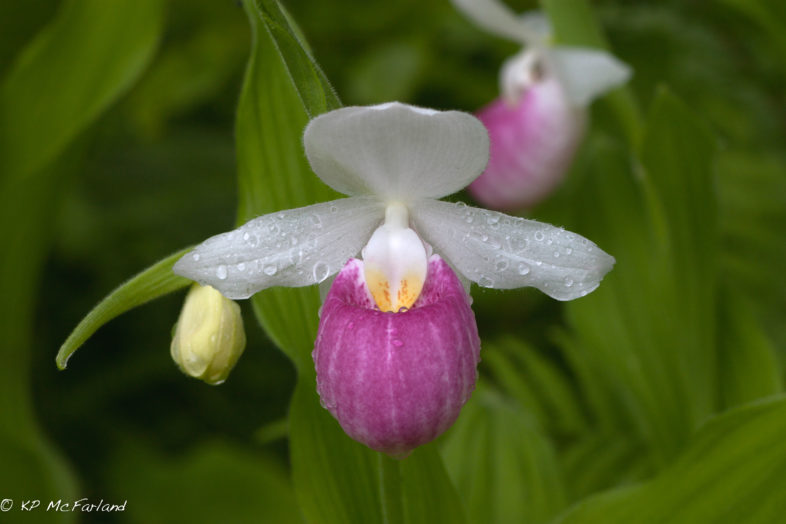
Showy Lady’s-slipper (Cypripedium reginae) after a rainstorm in Eshqua Bog, Hartland, Vermont. / © K.P. McFarland – www.kpmcfarland.com
There are about 47 species in the orchid genus Cypripedium, the Lady’s Slipper. Lucky for me three of them bloom within just a short distance from my house. Yellow and Showy Lady’s Slippers grow in a nearby fen and the more upland, acidic loving Pink Lady’s Slipper can be found in mixed pine woodlands.
Gems of the forest to me, but just a tease and a trap for pollinators. There is no edible reward for their pollinating help. The beautiful pigmentation and scent entices insects to enter the flowers down through the labellum, the irregularly shaped petal that forms the “slipper”, of the Showy and Yellow Lady’s Slippers. Unlike most Cypripedium, insects enter the Pink Lady’s Slipper through a slit that runs the length of the labellum. Either way the insects become trapped in the slipper without any nectar and soon begin to move around wildly trying to find an escape route.
Pollen grains are stuck on structures called pollinia. These are behind a shield near the opening called the staminode. When the insect enters the flower, it cannot come into contact with the flower’s own pollen. This prevents self-pollination. To escape, the insect exerts pressure on the stigma creating a larger escape hatch. If it has pollen grains on its body from a previous flower, they are likely to stick to the stigma. The only passage to freedom from there is past the pollinia where a sticky mass of pollen will adhere to its body on the way out. With luck, it will visit another Lady’s Slipper to transfer the pollen. But after a few visits to these flowers, they usually catch on that there is no nectar reward inside the flower and begin to avoid Lady’s Slipper flowers. This might explain the low seed set for these orchids.
Who are the pollinators for these deceptive flowers? A study of the population of Showy Lady’s Slippers near my house found that over 90% of the pollination was done by hoverflies with a minor contribution from flower beetles. Others have found leafcutter bees visiting the flowers.
Recently, Martha Case and Zachary Bradford from the College of William and Mary came up with an ingenious method for discovering visiting pollinators. They used a piece of ribbon and a clip to block the escape passage from the slipper. They found a near threefold increase in pollinator detection in Yellow Lady’s Slippers. Ten bee species from four families (Andrenidae, Apidae, Halictidae and Megachilidae) were found in the flowers.
For an insect, beauty is indeed only skin deep when it comes to the Lady’s Slippers.
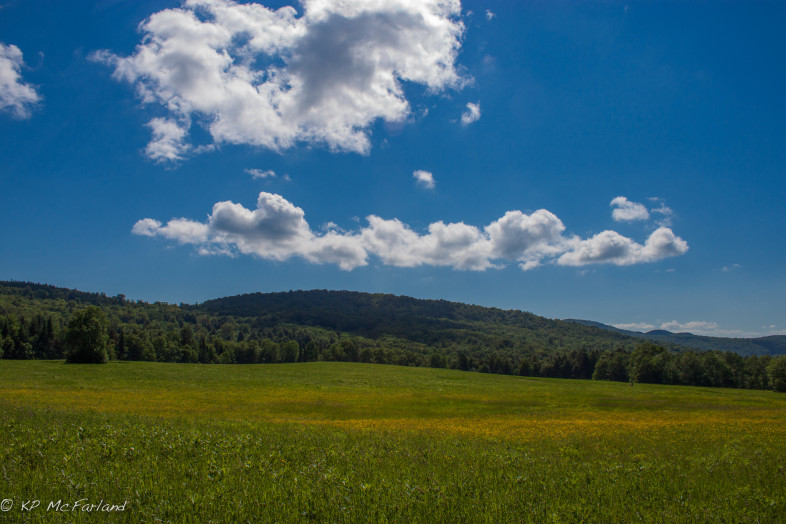
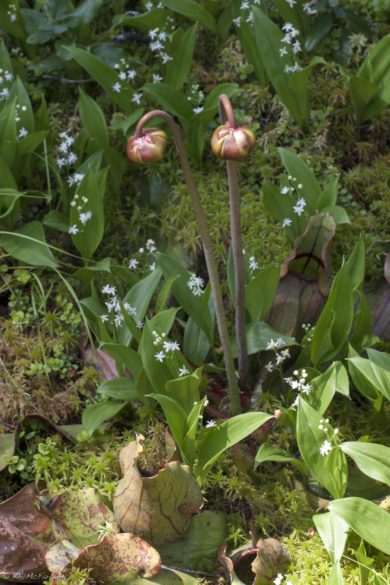
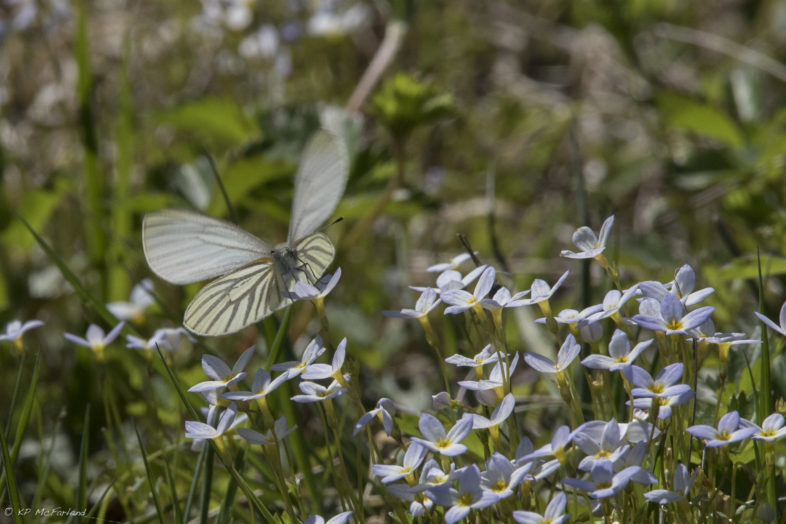
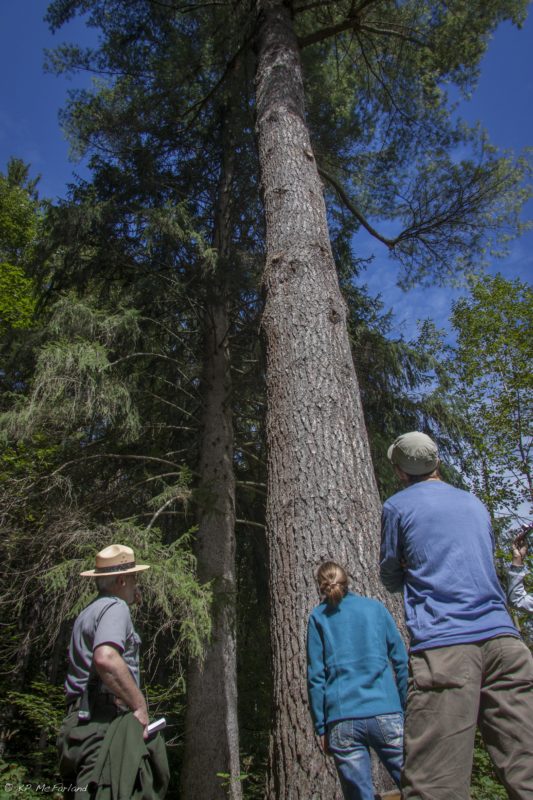
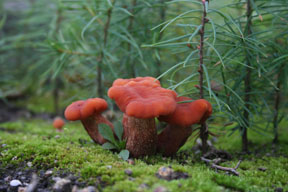
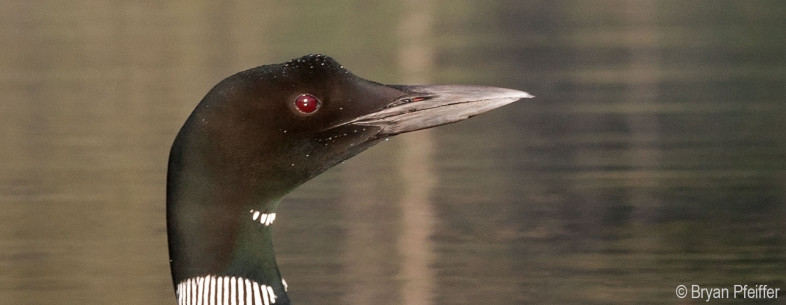
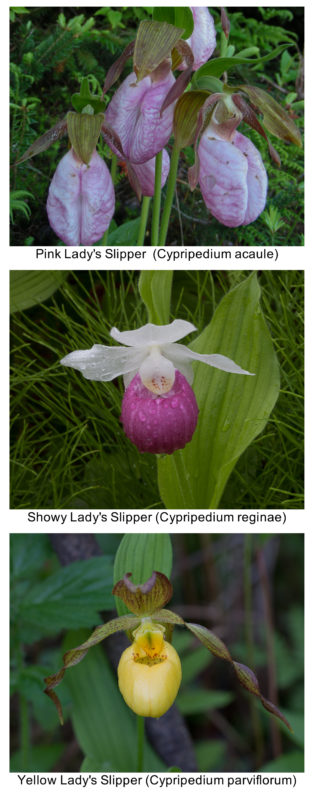

So much information here!! Fascinating. Thanks.
The Loons have such beautiful. I just did not know what they meant. Thank You. Pam K
Meat-eating trees? I expected large stately elms dropping dead limbs onto unsuspecting deer below with root claws emerging from the soil dragging the deer carcasses underground to be consumed by microrhizal root hairs.
Wow, that would be something! But that sounds more like the sci fi channel 🙂
So jealous is all of your sightings and photos, Kent McF! Keep up the good work! Great job and wonderful education! bb
Thank you so much Betsy. I am glad you enjoy them and I hope you can get outside and share some of your discoveries with us too!
Many thanks for sharing information about the amazing life webs of Pitcher Plants, meat-eating White Pines and the hover-fly connection with Lady’s Slippers. I’ll definitely share this information…and your website…with friends and NatureHaven day campers. 🙂
Super! Thank you so much. I am glad you like it and are sharing!
Kent, thanks for your blog; it is always well-written and so full of interesting observations. I’ll be careful not to sleep under White Pines from now on, so as to not be mistaken for a springtail.
The Buggerman Pine In the Great Smokey Mountains National Park in North Carolina was accurately measured to 207′ tall before a storm blew it’s top off, so it is now about 188′ tall. It was the only white pine ever accurately measured to over 200 feet tall.